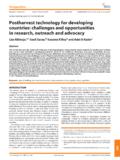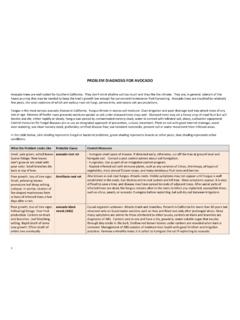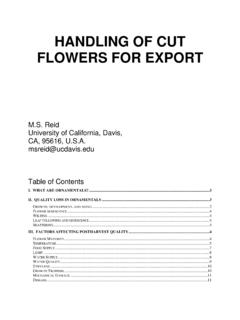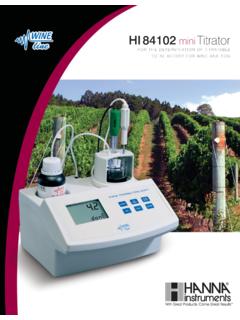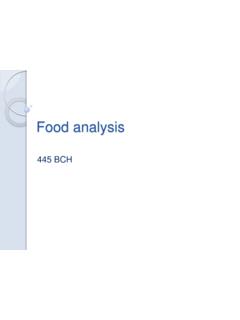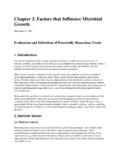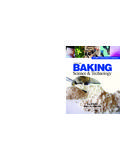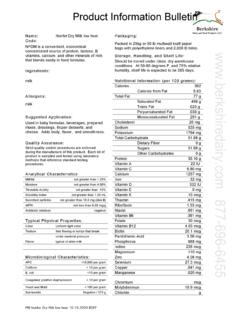Transcription of Methods for Determining Quality of Fresh …
1 Page 1 Perishables Handling Newsletter Issue No. 85 February 1996 Updated 6/16/03 VISUALThe visual appearance of Fresh fruits and vegetables is one ofthe first Quality determinants made by the buyer whether thewholesaler, retailer or consumer. Often the appearance of thecommodity is the most critical factor in the initial purchase (inaddition to price) while subsequent purchases may be morerelated to texture and perceive color when light reflected off the fruit orvegetable s surface falls upon the eye s retina; there is nocolor without light. Color perception depends on the typeand intensity of light, chemical and physical characteristics ofthe commodity, and the person s ability to characterize color can be subjective or objective:Subjective: The human eye is used to evaluate :1. Faster and easier than objective Requires no specialized Color charts or guides can be used as references formatching and describing colors as in bananas,nectarines and :1.
2 Results can vary considerably due to human differ-ences in color perception and human Available light quantity and Quality can influence : An instrument is used to provide a specific colorvalue based on the amount of light reflected off the commod-ity surface or the light transmitted through the :1. Less variability in color Can measure small differences in color Can be automated on the Portable hand-held units are available (fig. 1).Disadvantages:1. Requires specialized equipment at a significant May be slower than subjective scoring of color may be more practical and fasterand values can be referenced to objective color values and topigment concentrations. For small leafy tissues, for example,samples representative of a 5 point color scale are evaluatedfor objective color values and chlorophyll and carotenoidconcentrations. Routine evaluations are done by subjectivescoring, but referencing to objective measurements addsvaluable information to the 1.
3 Determination of commodity color can be accomplishedsubjectively through the use of comparative color charts or objectivelywith a Minolta Colorimeter. Color charts can be very effective and usefulif the colors truly match the color change in the commodity of Minolta Colorimeter can detect small differences in color andprovides separate values for lightness to darkness, green to red and blueto yellow Notation:Hue: Red, yellow, green, blue, purple or intermediate colorsbetween adjacent pairs of these basic colors, RY, YG,GB, of lightness: The degree to which an object is judgedto reflect more or less light than another or saturation: The degree of departure from thegray of the same for Determining Quality ofFresh Commoditiesby Beth Mitcham, Marita Cantwell, and Adel KaderPerishables Handling Newsletter Issue No. 85 February 1996 Page 2 Updated 6/16/03 GlossGloss is a visual aspect of Quality that depends on the abilityof a surface to reflect light.
4 Products that are freshly har-vested often have a bright, glossy surface and this appear-ance factor can be greatly reduced with weight loss and otherpostharvest handling conditions. There are small portableinstruments from Minolta and BKY Gardner for measurementof & SizeUniform and characteristic shape are important qualitycharacteristics. Misshapen products may be more suscep-tible to mechanical injury and are generally avoided byconsumers. Another example where shape is important is forbroccoli. For the Fresh market, compact broccoli florets aredesirable while for Fresh -cut, space between the florets isimportant to allow for cutting without injury. Size of productcan also be important depending on its intended tend to associate large size with higher qualityand view larger fruit as more subjective evaluation of size and shape can beconducted on incoming product once the desirable andundesirable characteristics are determined. Size and shapecharts are available for various commodities and weight is afairly accurate measure of product size.
5 The percentage ofproduct which does not meet the desired characteristics canbe of DefectsThe product should be evaluated for the presence of level of tolerance for each type of defect such as cuts,bruises, disease, low-temperature injury, and physiologicaldisorders should be determined. During Quality evaluation,the percentage of fruit with each class of defect can bedetermined as a guide to overall product Quality . A scoringsystem (such as 1 = none, 2 = slight, 3 = moderate, 4 = severe,and 5 = extreme) can be used to describe the incidence andseverity of , or the degree of softness or crispness, is oftenmeasured using objective instruments. Subjective measure offirmness with the fingers can be useful for quick measures ofgross differences in firmness, particularly of soft are several firmness testers available including:1. Magness-Taylor pressure tester - slide rule-type, spring-loaded Effe-gi fruit penetrometer - hand-held probe with gauge Effe-gi penetrometer mounted on a drill-press UC Fruit Firmness Tester - Ametek penetrometer mountedon a drill-press Deformation Tester - determines deformation force for #1 through 4 measure penetration force;instrument #5 measures deformation force and may be usedfor some fruits, such as tomatoes, papayas, and of some of these instruments can be seen in Figures 2and probes used in the instruments described abovecan also be mounted on computerized texture analyzers,which eliminate much operator variability.
6 This allows notonly determination of maximum force values, but also atexture profile. For example, a texture profile can showdifferences in the texture of chilled and nonchilled 2. The most common way to measure firmness is resistanceto compression or pounds-force (lbf.). There are three basic types ofpenetrometers available. The original Magness-Taylor has a slide-ruletype device for measuring lbf. and is reliable, but bulky and heavy. TheEffe-gi penetrometer is lightweight and easy to carry with an easy to readdial. Mounting the force guage on a drill-press stand, as seen in the UCFirmness Tester, increases the potential accuracy of results. Removethe peel before compression unless the peel is the tissue of interest forfirmness measurement (usually is not).Page 3 Perishables Handling Newsletter Issue No. 85 February 1996 Updated 6/16/03 Figure 3. Texture Analysis system from Texture Technologies Size and Selection for Firmness1. Select a random sample of product from several representa-tive boxes including at least 15 to 25 fruits or vegetables or 3%of the Select product with a uniform size to avoid variation infirmness due to size (large fruit are usually softer thansmaller fruit).
7 3. Make sure all fruit tested are comparable in temperaturesince warm fruit are usually softer than cold Use of Firmness Testers1. Make 2 puncture tests per fruit (except very small fruit),once on each opposite cheek, midway between the stemand blossom end on sun and shade sides; avoid sun-burned Remove a disc (larger than the tip to be used) of the skinwith a vegetable peeler or sharp Use an appropriate tip (plunger), see Table 1, for All determinations for a given lot should be made by oneperson to minimize Hold the fruit against a stationary, hard surface and forcethe tip into the fruit at a uniform speed (take 2 seconds).6. Depth of penetration should be consistently to the scribedline on the Record reading to the nearest lb-force or 1. Recommended tip sizes for firmness sizeCommodities11 mm (7/16-inch) Apple8-mm (5/16-inch) Apricot, avocado, kiwifruit, mango, nectarine,papaya, peach3-mm (1/8-inch) Cherry, grape, (1/16-inch) OliveProper Units for FirmnessIt is inappropriate to use the term pressure in associationwith firmness measurements using the devices describedabove.
8 While pounds-force or kg-force are preferred in theindustry, Newton (N) is the required unit for scientific conversion factors are as follows:pound-force (lbf) x = Newton (N)kilogram-force (kgf) x = Newton (N)Maintenance of Firmness Testers1. Before use each day, work the plunger in and out for 10seconds to loosen up the springs inside the Clean the tips after use to prevent clogging of themechanism with of Firmness Testers1. Hold the firmness tester in a vertical position and place thetip onto the pan of a Press down slowly on the firmness tester until the scaleregisters a given weight, then read the firmness this comparison 3 to 5 times. If you find that theinstrument is properly calibrated, it is ready to If the instrument is not in agreement with the scale, findout the magnitude and direction of the differences andproceed as follows:Magness-Taylor Pressure Tester: Remove the plunger assembly from the barrel of theinstrument and remove the bolt and washers from the endof the plunger assembly.
9 Pull the plunger and spring out of the metal cylinder, thenshake the washers out of the cylinder. To make the instrument read lower, move washers frominside to outside the metal cylinder. To make the instrument read higher, move washers fromoutside to inside the metal cylinder. Reassemble and recheck for Handling Newsletter Issue No. 85 February 1996 Page 4 Updated 6/16/03 Figure 4. A wedge is cut from the commodity from stem to blossom endand to the center. The juice is extracted with a garlic press and a fewdrops are placed onto the glass of the refractometer. The refractometeris closed and held up to the light for viewing through the eyepiece. Theinternal scale will show the SSC of the 5. Digital refractometerThe temperature of the juice is a critical factor foraccuracy because all materials expand when heated andbecome less dense. For a sugar solution, the change is sugar for every C (10 F). Good Quality refractome-ters have a temperature compensation capability or at least athermometer attached to them so that the operator can makethe necessary corrections.
10 It is essential to clean therefractometer between each reading and to standardize it withdistilled water (should read a refractive index of at 20 C(68 F) or 0% SSC).TITRATABLE ACIDITYT itratable acidity (TA) can be determined by titrating aknown volume of fruit juice with N NaOH (sodiumhydroxide) to an end point of pH = as indicated byphenolphthalein indicator or by using a pH meter. (NaOH isadded to the juice until the pH changes to The millilitersof NaOH needed is used to calculate the TA) The TA,Effe-gi Fruit Penetrometer: Unscrew the chrome guider nut to remove the plungerassembly. To make the instrument read lower, insert washersbetween the spring and the stationary brass guide. To make the instrument read higher, insert washersbetween the chrome guide nut and the stationary brassguide on the plunger shaft. Reassemble and recheck for calibration. If the indicator needle does not stop or does not releasebutton hold, remove the plunger assembly, and thenlubricate the inside of the instrument with an measurements may be useful for some fruitvegetables (melons, peppers) and even root vegetables(carrots, potato), but other measurements of texture areneeded for stem and leafy tissues such as asparagus orcelery (force for a blade to cut or shear).
